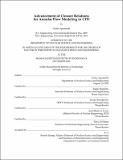Advancement of closure relations for annular flow modeling in CFD
Author(s)
Agostinelli, Giulia.
Download1227106656-MIT.pdf (11.78Mb)
Other Contributors
Massachusetts Institute of Technology. Department of Nuclear Science and Engineering.
Advisor
Emilio Baglietto.
Terms of use
Metadata
Show full item recordAbstract
In Boiling water Reactors (BWRs), the presence of a liquid film in contact with the heated rod surface is crucial to ensure an efficient heat removal and prevent the threatening occurrence of dryout. The accurate prediction of the complex multidimensional liquid film behavior in advanced BWR fuel assemblies is critical to guarantee improved reactors performance and safety. Multiphase- CFD (M-CFD) brings the ability to model the complex three-dimensional flow structures in annular flow regime [1], while physics-based constitutive equations are needed to accurately represent the phase interactions, particularly at the liquid film interface. The development of closure relations for droplet deposition and entrainment as well as wave-induced interfacial shear, is a major priority for the modeling of annular flow in M-CFD. In annular flow conditions, liquid is continuously exchanged at the interface between the bulk steam and the film on the walls. While liquid droplets deposit onto the film driven by turbulent diffusion, new ones are entrained from the waves appearing on the film surface. A modeling approach is proposed and assessed to represent the local subgrid-scale deposition in CFD, showing comparable results with existing integral correlations, and an average error of 30%. Available closures are also evaluated for their ability to represent entrainment in the CFD implementation. Finally, in order to drive the advancement of the representation of interfacial shear, as well as physics-based droplet entrainment, the work focuses on the analysis and modeling of disturbance waves. The recent high resolution film measurements collected by Robers [2] are analyzed and leveraged to propose a physical representation of disturbance waves, which can be implemented into a complete model. The proposed model is successfully assessed against the experimental measurements of Sawant [3], while a large disagreement is found in comparison with the high pressure data evaluated at the RISO facility [4]. The new model predictions are consistent with existing integral correlations, demonstrating the need for further advancement of high pressure experiments with high resolution, necessary to drive more general representations. The complete set of closures is implemented in a commercial CFD software, and demonstrated adopting data from the Robers experiments. While the lingering limitations of the CFD implementation to transport thick films lead to overprediction of the local film thickness, the formulation shows promising performance towards more fundamental modeling of annular flow in M-CFD.
Description
Thesis: Ph. D., Massachusetts Institute of Technology, Department of Nuclear Science and Engineering, September, 2020 Cataloged from student-submitted PDF version of thesis. Includes bibliographical references (pages 118-124).
Date issued
2020Department
Massachusetts Institute of Technology. Department of Nuclear Science and EngineeringPublisher
Massachusetts Institute of Technology
Keywords
Nuclear Science and Engineering.